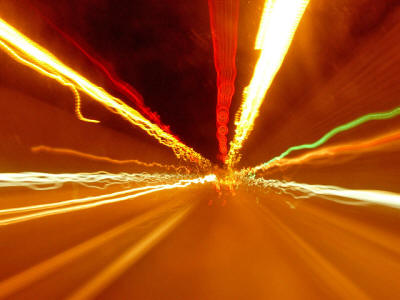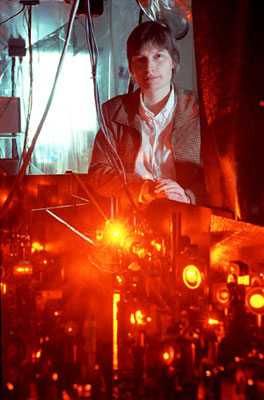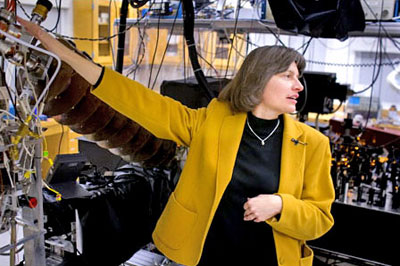|

by admin
June 26, 2012
from
WakingTimes Website

In two independent experiments that defy the
notions of Einstein,
researchers have been able to stop, then restart a beam of light.
Ordinarily, light travels at the speed of 186,282 miles per second,
but the research team of Lene Hau, a professor of physics at
Harvard, who
in 1999 was able to slow light down to 38 miles per
hour, has been able to trap light in a cloud of sodium atoms
super-cooled to near ‘absolute zero.’
“It’s nifty to look into the chamber
and see a clump of ultracold atoms floating there,” Hau says.
“In this odd state, light takes on a more human dimension; you
can almost touch it.” [1]
In an independent experiment, an easier
approach was tried by the team of Ronald Walsworth and Mikhail Lukin at the
Harvard-Smithsonian Center for Astrophysics (CfA).
They shot laser beams through a dense cloud of rubidium and helium
gas. (Rubidium, in its solid or natural form, is a soft,
silver-white metal.) The light bounced from atom to atom, gradually
slowing down until it stopped.
No supervacuum or ultra-cold was needed.
In fact, the chamber where the light stopped was at a temperature of
176 degrees F. [1]
Both experiments accomplish almost the same thing, however, in the
CfA experiment researchers were only able to store about half of the
incoming light, and the storage time was about half that of Hau’s
experiment.
Think of both contraptions as sophisticated light switches that
control not just light but information. Incoming light can carry
information expressed by changes or modulations of its frequency,
amplitude, and phase. When the light stops, that information is
stored just like information is stored in the electronic memory of a
computer.
To access the information, you turn on a control laser,
and out it comes. [1]
Remarkably, scientists are somewhat uncertain about
the implications
and practicality of this research.
“We hope for wonderful things,” says
David Phillips, who worked on the CfA 'stop light' project. “Our
imagination hasn’t figured out what the possibilities are yet.”
[1]
However, there appear to be clear
implications for using experiments like this to ultimately improve
the speed of computers, potentially creating the possibility to
shift from binary computing to quantum encoding of data.
Computers operating by these so-called quantum effects are much more
efficient that those available today, or even on the drawing board.
(“Quantum” refers to changes in the energy levels of the atoms.)
Today’s machines represent information in bits, electronic
combinations of zeros and ones. Bits represented by quantum states of
atoms could carry much, much more information. Cubic inch for cubic
inch, quantum computers could tackle problems that would stymie the
most super of conventional computers.
For example, they could
perform many calculations simultaneously. [1]
The eminent physicist Albert Einstein theorized that it was
impossible for light to travel at a speed faster than 186,282 miles
per second, and in this case he has not yet been proven wrong.
Watch the following video for amazing footage of Hau’s research:
Source
[1]
Researchers Now Able to Stop, Restart Light
Light and Matter United - Opens The Way to
New Computers and Communication Systems
Researchers Now Able to...
Stop, Restart Light
by William J. Cromie
Gazette Staff
January 24, 2001
from
HarvardGazetteUniversity Website

Lene Hau and her colleagues created a new form of matter
to bring a
light beam to a complete stop, then restart it again.
(Staff photo by
Kris Snibbe)
"Two years ago we slowed it down to 38 miles an hour; now we've been
able to park it then bring it back up to full speed."
Lene Hau isn't
talking about a used motorbike, but about light - that ethereal,
life-sustaining stuff that normally travels 93 million miles from
the sun in about eight minutes.
Less than five years ago, the speed of light was considered one of
the universe's great constants. Albert Einstein theorized that light
cannot travel faster than 186,282 miles per second. No one has
proved him wrong, but he never said that it couldn't go slower.
Hau, 41, a professor of physics at Harvard, admits that the famous
genius would "probably be stunned" at the results of her
experiments.
Working at the Rowland Institute for
Science, overlooking the Charles River and the gold dome of the
state Capitol in Boston, she and her colleagues slowed light 20
million-fold in 1999, to an incredible 38 miles an hour. They did it
by passing a beam of light through a small cloud of atoms cooled to
temperatures a billion times colder than those in the spaces between
stars.
The atom cloud was suspended
magnetically in a chamber pumped down to a vacuum 100 trillion times
lower than the pressure of air in the room where you are reading
this.
"It's nifty to look into the chamber
and see a clump of ultracold atoms floating there," Hau says.
"In this odd state, light takes on a more human dimension; you
can almost touch it."
She and her team continued to tweak
their system until they finally brought light to a complete stop.
The light dims as it slows down, so you
think that it's being turned out. Then Hau shoots a yellow-orange
laser beam into the cloud of atoms, and the light emerges at full
speed and intensity.
Inspired by Hau's success at slowing light, researchers working on a
wooded hill a few miles away at the Harvard-Smithsonian Center for
Astrophysics (CfA) used a similar technique to stop, then restart, a
light beam.
That team was headed by Ronald Walsworth and Mikhail Lukin, both associates of Harvard College.
Their success was independent of Hau's
effort.
"We didn't have much contact," she
notes, "just a few e-mails."
Stopping cold
Besides stirring a research rush to explore exotic forms of matter,
such experiments open the door to some practical applications.
These include vastly more powerful
computers as well as the possibility of communications that are much
more secure from hackers and people trying to steal your credit and
bank card numbers.
"We hope for wonderful things," says
David Phillips, who worked on the CfA "stop light" project. "Our
imagination hasn't figured out what the possibilities are yet."
Hau, a tall, slender scientist educated
as a theoretical physicist in Denmark, had a hunch several years ago
that intensely cold atoms would become a hot area in physics.
In the mid-1990s, she and her colleagues
became excited about experiments aimed at crowding atoms so close
together that unusual things happen. The key is to cool them to
within a billionth of a degree of minus 459.7 degrees F.
Called "absolute zero," this is the
temperature at which atoms have the least possible energy, and they
all but cease to move around.
Hau was one of several researchers who succeeded in creating this
novel state of matter. She corresponded with a colleague, Stepen
Harris at Stanford University, and they came up with the idea
that it might be possible to use a small ball of cold atoms to slow
down light.
Hau and her group then figured out a way to make it work. Using
sodium atoms and two laser beams, they made a new kind of medium
that entangles light and slows it down.
The laser beams glow yellow-orange like
sodium streetlights, and the cigar-shaped cloud of atoms is about
eight-thousandths of an inch long and about a third as wide.
Working with Chien Liu, a postdoctoral fellow at Rowland, and
Harvard graduate students Zachary Dutton and Cyrus
Behroozi, Hau kept tweaking the atoms until they completely
stopped laser light. This happens when a second laser beam directed
at right angles to the cloud of atoms is cut off.
When that laser is
switched on again, it abruptly frees the light from the trap and it
goes on its way.
Hau explains that light entering the atomic entanglement transfers
its energy to the atoms. Light energy raises the atoms to higher
energy levels in ways that depend on the frequency and intensity of
the light.
The laser illuminating the cloud at
right angles to the incoming beam acts like a parking brake,
stopping the beam inside the cloud when it is shut off. When it is
turned on again, the brake is released, the atoms transfer their
energy back to the light, and it leaves the end of the cloud at full
speed and intensity.
Hau's team stopped light for one-thousandth of a second.
Atomically
speaking,
"this is an amazingly long time,"
Hau notes. "But we think it can be stopped for much longer."
The CfA researchers used an easier
method.
They shot laser beams through a dense
cloud of rubidium and helium gas. (Rubidium, in its solid or natural
form, is a soft, silver-white metal.) The light bounced from atom to
atom, gradually slowing down until it stopped. No supervacuum or
ultra-cold was needed. In fact, the chamber where the light stopped
was at a temperature of 176 degrees F.
This convenience comes at a cost, however. Only half of the incoming
light was stored, then recovered, and the storage time was much
shorter.
Think of both contraptions as sophisticated light switches that
control not just light but information. Incoming light can carry
information expressed by changes or modulations of its frequency,
amplitude, and phase. When the light stops, that information is
stored just like information is stored in the electronic memory of a
computer.
To access the information, you turn on a
control laser, and out it comes.
Shrinking
computers
Computers operating by these so-called quantum effects are much more
efficient that those available today, or even on the drawing board.
("Quantum" refers to changes in the energy levels of the atoms.)
Today's machines represent information in bits, electronic
combinations of zeros and ones.
Bits represented by quantum states of
atoms could carry much, much more information. Cubic inch for cubic
inch, quantum computers could tackle problems that would stymie the
most super of conventional computers. For example, they could
perform many calculations simultaneously.
Another thing they could do would be to encrypt information in
complex codes impossible to crack without extremely expensive and
time-consuming methods. Financial and other information would be
prodigiously safer with a quantum computer.
As marvelous as they are, however, both the Rowland and CfA systems
take up more space and power than would be practical. Hau's
experiment requires a small room, CfA's needs a large tabletop.
CfA researchers need to solve this problem and to make sure all the
light is stored - not just half. That will take many years.
Hau has already started ordering and installing equipment with which
she plans to construct a quantum light stopper no bigger than a
fingernail. She envisions ultracold and supervacuums being achieved
with devices less than one-thousandth of an inch in size.
These would be built on chips no bigger
than the Pentium IV that runs many of today's small laptop and
palm-sized computers.
"Wouldn't that be nifty!" Hau says.
She and her colleagues describe their
experiment in detail in today's issue of the journal Nature.
Light and Matter United
-
Opens The Way to New Computers and
Communication Systems -
by William J. Cromie
Harvard News Office
February 8, 2007
from
HarvardGazetteUniversity
Website
recovered through
WayBackMachine Website

Lene Hau Explains How
She Stops Light in One Place
Then Retrieves and
Speeds it Up in A Completely Separate Place
Staff photo Justin Ide/Harvard News Office
Lene Hau has already shaken scientists' beliefs about the
nature of things.
Albert Einstein and just about every
other physicist insisted that light travels 186,000 miles a second
in free space, and that it can't be speeded-up or slowed down.
But in 1998, Hau, for the first time in
history, slowed light to 38 miles an hour, about the speed of
rush-hour traffic.
Two years later, she brought light to a complete halt in a cloud of
ultracold atoms. Next, she restarted the stalled light without
changing any of its characteristics, and sent it on its way. These
highly successful experiments brought her a tenured professorship at
Harvard University and a $500,000 MacArthur Foundation award to
spend as she pleased.
Now Mallinckrodt Professor of Physics and of Applied Physics, Hau
has done it again.
She and her team made a light pulse
disappear from one cold cloud then retrieved it from another cloud
nearby. In the process, light was converted into matter then back
into light. For the first time in history, this gives science a way
to control light with matter and vice versa.
It's a thing that most scientists never thought was possible.
Some colleagues had asked Hau,
"Why try that experiment? It can't
be done."
In the experiment, a light pulse was
slowed to bicycle speed by beaming it into a cold cloud of atoms.
The light made a "fingerprint" of itself
in the atoms before the experimenters turned it off. Then Hau and
her assistants guided that fingerprint into a second clump of cold
atoms.
And get this - the clumps were not
touching and no light passed between them.
"The two atom clouds were separated
and had never seen each other before," Hau notes. They were
eight-thousandths of an inch apart, a relatively huge distance
on the scale of atoms.
The experimenters then nudged the second
cloud of atoms with a laser beam, and the atomic imprint was revived
as a light pulse.
The revived light had all the
characteristics present when it entered the first cloud of atomic
matter, the same shape and wavelength. The restored light exited the
cloud slowly then quickly sped up to its normal 186,000 miles a
second.
Communicating
by light
Light carries information, so think of information being manipulated
in ways that have never before been possible.
That information can be stored - put on
a shelf, so to speak - retrieved at will, and converted back to
light. The retrieved light would contain the same information as the
original light, without so much as a period being lost.
Or the information could be changed.
"The light waves can be sculpted,"
is the way Hau puts it. "Then it can be passed on. We have
already observed such re-sculpted light in our lab."
A weird thing happens to the light as it
enters the cold atomic cloud, called a Bose-Einstein condensate.
It becomes squeezed into a space 50
million times smaller. Imagine a light beam 3,200 feet (one
kilometer) long, loaded with information, that now is only a hair
width in length but still encodes as much information.
From there it becomes easier to imagine new types of computers and
communications systems - smaller, faster, more reliable, and
tamper-proof.
Atoms at room temperature move in a random, chaotic way. But when
chilled in a vacuum to about 460 degrees below zero Fahrenheit,
under certain conditions millions of atoms lock together and behave
as a single mass.
When a laser beam enters such a
condensate, the light leaves an imprint on a portion of the atoms.
That imprint moves like a wave through the cloud and exits at a
speed of about 700 feet per hour. This wave of matter will keep
going and enter another nearby ultracold condensate. That's how
light moves darkly from one cloud to another in Hau's laboratory.
This invisible wave of matter keeps going unless it's stopped in the
second cloud with another laser beam, after which it can be revived
as light again.
Atoms in matter waves exist in slightly different energy levels and
states than atoms in the clouds they move through. These energy
states match the shape and phase of the original light pulse.
To make a long story short, information
in this form can be made absolutely tamper proof. Personal
information would be perfectly safe.
Such a light-to-matter, matter-to-light system,
"is a wonderful thing to wrap your
brain around," Hau muses.
Details of the experiments appear as the
cover story of the Feb. 8 issue of Nature. Authors of the report
include graduate student Naomi Ginsberg, postdoctoral fellow
Sean
Garner, and Hau.
In a practical
manner
You won't see a light-matter converter flashing away in a factory,
business, or mall anytime soon.
Despite all the intriguing
possibilities,
"there are no immediate practical
uses," Hau admits.
However, she has no doubt that practical
systems will come. And when they do, they will look completely
different from anything we are familiar with today.
They won't need a lot of wires and
electronics.
"Instead of light shining through
optical fibers into boxes full of wires and semiconductor chips,
intact data, messages, and images will be read directly from the
light," Hau imagines.
Creating those ultracold atomic clouds
in a factory, office, or recreation room will be a problem, but one
she believes can be solved.
"The atomic clouds we use in our lab
are only a tenth of a millimeter (0.004 inch) long," she points
out.
"Such atom clouds can be kept in small containers, not all
of the equipment has to be so cold. Most likely, a practical
system designed by engineers will look totally unlike the setup
we have in our lab today."
There are no "maybes" in Hau's voice.
She is coolly confident that
light-to-matter communication networks, codes, clocks, and guidance
systems can be made part of daily life. If you doubt her, remember
she is the person who stopped light, converted it to matter, carried
it around, and transformed it back to light.
|



